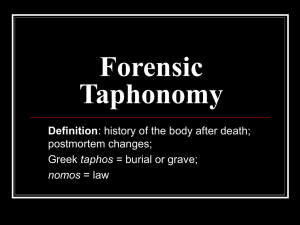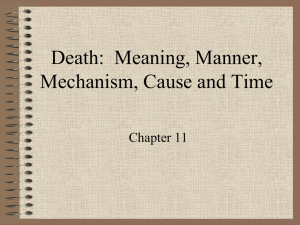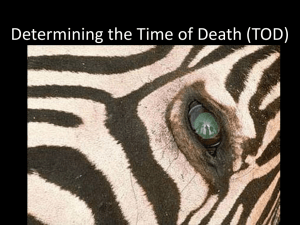Postmortem Changes In The Eye
advertisement
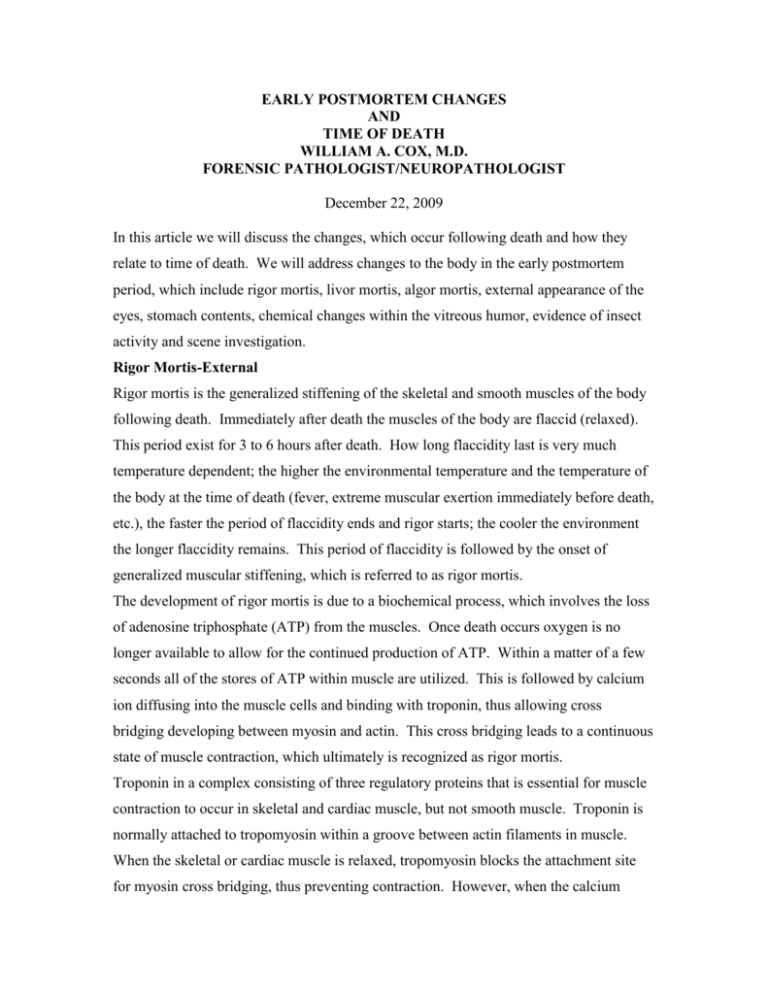
EARLY POSTMORTEM CHANGES AND TIME OF DEATH WILLIAM A. COX, M.D. FORENSIC PATHOLOGIST/NEUROPATHOLOGIST December 22, 2009 In this article we will discuss the changes, which occur following death and how they relate to time of death. We will address changes to the body in the early postmortem period, which include rigor mortis, livor mortis, algor mortis, external appearance of the eyes, stomach contents, chemical changes within the vitreous humor, evidence of insect activity and scene investigation. Rigor Mortis-External Rigor mortis is the generalized stiffening of the skeletal and smooth muscles of the body following death. Immediately after death the muscles of the body are flaccid (relaxed). This period exist for 3 to 6 hours after death. How long flaccidity last is very much temperature dependent; the higher the environmental temperature and the temperature of the body at the time of death (fever, extreme muscular exertion immediately before death, etc.), the faster the period of flaccidity ends and rigor starts; the cooler the environment the longer flaccidity remains. This period of flaccidity is followed by the onset of generalized muscular stiffening, which is referred to as rigor mortis. The development of rigor mortis is due to a biochemical process, which involves the loss of adenosine triphosphate (ATP) from the muscles. Once death occurs oxygen is no longer available to allow for the continued production of ATP. Within a matter of a few seconds all of the stores of ATP within muscle are utilized. This is followed by calcium ion diffusing into the muscle cells and binding with troponin, thus allowing cross bridging developing between myosin and actin. This cross bridging leads to a continuous state of muscle contraction, which ultimately is recognized as rigor mortis. Troponin in a complex consisting of three regulatory proteins that is essential for muscle contraction to occur in skeletal and cardiac muscle, but not smooth muscle. Troponin is normally attached to tropomyosin within a groove between actin filaments in muscle. When the skeletal or cardiac muscle is relaxed, tropomyosin blocks the attachment site for myosin cross bridging, thus preventing contraction. However, when the calcium channels open, either as the result of an action potential or the increase in permeability of the cellular membrane immediately after death in the sarcoplasmic reticulum, calcium enters the sarcoplasm attaching to troponin, causing a conformational change that removes tropomyosin so that cross bridging between myosin and actin can take place and thus muscle contraction. The decrease in ATP also gives rise to an accumulation of lactic acid in the myocytes, which also makes a contribution toward the development of muscle contraction and thus rigor in skeletal and cardiac muscles. It is believed that the development of contraction of smooth muscle (rigor mortis) in the postmortem period is solely due to the accumulation of intracellular lactic acid secondary to anaerobic breakdown of carbohydrates, in light of the fact that smooth muscle lacks troponin. How prominent rigor manifest itself is dependent on the degree of skeletal muscle development. For example, the development of rigor mortis in infants, the elderly, those who are malnourished (cachetic), and the markedly obese tends to be minimal and in some cases not recognizable. Although rigor develops in all muscles simultaneously and at the same rate it usually becomes recognizable in the smaller muscle groups first, hence you tend to see it first in the face, jaw and neck followed by the development of rigor in the trunk and extremities. Typically in the classic average person, who dies in an environment with a temperature of 70°F, rigor starts to appear within 2 to 4 hours, reaching its completion or maximum in 6 to 12 hours. It is most important to keep in mind this process is very temperature dependent; the higher the temperature the faster rigor develops. As the decomposition process sets in rigor is gradually loss; it typically disappears in the same fashion it begins, face, jaw and neck followed by the trunk and extremities. In a 70°F environment rigor begins to dissipate at approximately 18 hours and is completely gone by about 36 hours. In cooler temperatures, but not freezing, rigor can persist for several days. In freezing temperatures, once the body’s temperature is that of the environment, the muscles become hard as well as the adipose tissue due to intracellular and intercellular fluid freezing. The temperatures that are required to accomplish this are generally lower 2 than 23 °F. Rigor mortis may develop if the body is warmed, however, if there has been extensive cellular damage due to freezing it may never or only weakly develop. If rigor is broken before it reaches its maximum development (6 to 12 hours) it will develop in the new position. However, once rigor has reached its maximum development it will not redevelop. Thus, if rigor has reached its maximum development and the body is moved, consequently assuming a different position, rigor will not change such that the body conforms to the new position. This is one of the means you can use to tell if the body has been moved at the scene. It is important that the pathologist doing the autopsy note the degree of rigor and where it is seen on the body. It is not uncommon to find the description of rigor at the scene to be different from the rigor seen at the time of examination of the body in the autopsy suite. As an example, the lack of rigor in the shoulders, elbows and wrist, but prominent in the lower extremities at the time of the pathologist examination may be due to the removal of the deceased clothing. Rigor Mortis Affecting Other Organs Immediately after death the pupils typically assume a midposition, with a diameter of approximately 4 to 5 mm due to laxness of the papillary muscles. As rigor sets in the papillary size may change often with the size differing between the eyes; it is also not uncommon for the pupils to have an irregular configuration. The difference in size and conformation of the pupils is due to the lack of uniformity of rigor affect on the papillary muscles. Rigor mortis causes the myocytes of the heart to contract. This can manifest itself with slit-like ventricles and hypertorphic appearing left ventricular wall suggesting hypertensive cardiovascular disease. This can in part be ameliorated through weighing the heart and comparing with the weight of the deceased, the thickness of the left ventricular wall, interventricular septum and the right ventricular wall, the existence of left atrial enlargement, the overall configuration of the right atrium (ovoid configuration due to dilatation suggest pulmonary hypertensive heart disease), and the presence of hyaline arteriolosclerosis and or hyperplastic arteriolosclerosis involving the renal vasculature. 3 The finding of seminal fluid in the underwear, on one of the thighs, or at the end of the meatus is not typically the result of antemortum sexual activity, but rather due to rigor mortus giving rise to contraction of the dartos muscle and the muscles of the seminal vesicles and prostate with expulsion of seminal fluid. The dartos muscle is a layer of smooth muscle, which lies immediately beneath the skin of the scrotum but external to the spermatic fascia. It is a continuation of Camper’s fascia of the anterior abdominal wall. This muscle acts to regulate the temperature of the testicles, which promotes spermatogenesis through expanding and contracting which gives rise to wrinkling of the skin. It also aids the cremaster muscle to elevate the testis. In older males the dartos muscle loses its tone, which causes the scrotum to have a more smooth appearance with the scrotum hanging down further. The smooth muscles attached to the hair follicles (erector pili) are also affected by rigor and if pronounced can cause elevation of the cutaneous hairs and a ‘goose-flesh’-like appearance to the skin. Cadaveric Spasm Cadaveric spasm is a somewhat controversial entity that describes immediate rigor mortis that typically involves one group of voluntary muscles involved in a final desperate act associated with intense physical effort or extreme psychological stress. Examples would include vegetation in a clinched hand of a drowning victim. Livor Mortis (Hypostasis) Livor mortis is the result of the cessation of cardiac activity and the settling of blood in the capillaries and venules, thus distending them, in the dependent parts of the body. The dependent engorged blood vessels impart a purple-blue color to the overlying skin with the exception of those parts of the body serving as ‘pressure points.’ As an example, if someone dies in a supine position (resting on their back) livor mortis will develop on their back with the exception of the shoulder blades, buttocks, calves and heels. It is these parts of the body, which are supporting its weight and thus are referred to as ‘pressure points.’ The color of livor is ultimately determined by the degree of oxyhemoglobin present at the time of death. As stated the typical color of livor is purplish-blue. However, if the body has been refrigerated, the peripheral margins of the livor can appear red to pink. 4 Individuals who die as the result of hypothermia or drowning often develop a pink-red color to their livor mortis. Exactly how this occurs is not completely understood, although it appears to be related to higher levels of oxyhemoglobin in the cutaneous blood. How the higher levels of oxyhemoglobin arise may be related to the decrease in metabolic rate in the various organs including the skin, which gives rise to a decrease in oxygen uptake by the tissues. Why it occurs at the margins of the normal purplish-blue color of refrigerated bodies is still unknown. Those who die as a result of carbon monoxide poisoning have a pink-red to cherry-red color to their livor, the intensity of which is related to the levels of carboxyhemoglobin. It is alleged that cyanide poisoning gives rise to a dark blue to pink (scarlet) coloration to their livor, however, the coloration is not nearly as distinctive as that seen in carbon monoxide poisoning. Deaths due to methemaglobinemia are stated to give rise to a brownish to red-purple livor. Poisonings due to aniline and chlorate may also give rise to a brownish-red-purple coloration to their livor. Those who die as the result of septicemia/septic shock can have a mottled bronze-like color to their livor. Hydrogen sulfide gives rise to a green coloration due to sulfhemoglobinemia and even at low blood levels causes a pronounced cyanosis. Sulfhemoglobinemia is usually drug induced. Drugs associated with sulfhemoglobinemia include acetanilide, phenacetin, nitrates, trinitrotoluene and sulfur compounds (primarily sulphonamides). Another possible cause is occupational exposure to sulfur compounds. It can also be caused by phenazopyridine, which is a chemical that when secreted into the urine has a local analgesic effect, thus is commonly used in the initial treatment for urinary tract infections. Livor can be difficult to see in those with anemia or significant blood loss as well as dark pigmented persons. Obese individuals can show intense livor in the face, neck and upper chest. There are occasion in which, in addition to livor mortis in the dependent areas, you will also see minute circular red-purple hemorrhagic areas in the skin, which are often called Tardieu’s spots. It is important to understand these hemorrhages occur after death; hence they need to be differentiated from antemortem petechiae. There are some forensic pathologist who believe the term ‘tardieu spots’ should be restricted to those minute 5 circular hemorrhages lying beneath the visceral pleura of the lungs, where they were originally described by Parisian Professor Ambroise Tardieu in 1866, in the bodies of infants who had died as the result of ‘overlay.’ Tardieu-like spots can also appear on the surface of the skin as the result of blunt force trauma such as a slap across the face with an open hand or as the result of CPR. Livor mortis usually appears within 30 min to 2 hours after death. There is however some variability in the literature as to the onset of livor. Adelson’s used a time frame of 30 min to 4 hours for the onset, Spitz and Fisher 2 to 4 hours, Gradwohl 20 to 30 min, DiMaio 30 min to 2 hours and Knight 30 min to 2 hours. It has also been reported in those dying as the result of acute congestive heart failure or impairment of venous return to the heart can show the development of livor mortis in the antemortem period. It is typically stated that if the body remains in the same position as at the time of death for 6 to 12 hours livor mortis will become fixed. For example, should a person die lying on their back and remain in that position for 6 to 12 hours, livor mortis will become fixed on the posterior surface of their body with the exception of pressure points and will remain so even if their body is turned over onto their stomach. This is a helpful feature that can give you insight as to whether the body position was changed after death. Should you apply pressure with your finger onto the area of livor mortis it will not blanch. This is what is meant when the pathologist uses the phrase “fixed violaceous post mortem lividity extends over the anterior or posterior surface of the body with the exception of pressure points.” Should the body be moved before fixation has taken place, the livor will shift to the new dependent position. It should be understood that the time frames given for onset of livor and development of fixation are not rigid. Francis Camps reported a case in which livor was fixed within one hour of death. John Burton observed shifting of livor in bodies moved 24 hours after death. Perhaps the best study on the issue of shifting and fixation of livor mortis was that done by Suzutani et al. In their study involving 430 bodies livor was fixed in 30% of those deaths that were 6 to 12 hours old. In over 50% livor was fixed in those who had been dead for 12 to 24 hours and no fading occurred in 70% in those who had been dead for more than 1 to 3 days. However, there was a substantial number of cases in which livor was not fixed after 3 days, thus in some cases there can be 6 redistribution of livor up until decomposition commences with staining of the tissues due to hemolysis, which typically begins around 36 to 48 hours at a temperature of 70°F. This is often associated with a pronounced green discoloration to the surface of the skin in the right lower abdominal region. Due to the significant individual variation in the onset of livor mortis and the variability as to when it becomes fixed it cannot be used as a definitive reliable factor in determining time of death. This is not to suggest that livor mortis does not provide any useful information. In a general sense livor can provide some insight into the postmortem interval through its degree of development and whether a body has been moved after death. Livor found on the back of a body lying prone suggest that body has been moved several hours after death. Livor Mortis Affecting Internal Organs Livor mortis not only affects the external surface of the body, it also affects the internal organs. For example, in a person who dies in the supine position the posterior aspects of the lungs will have a deep blue to purple color due to dependent congestion and edema. Likewise, the posterior surface of the heart may show deep purple areas due to dependent congestion. The vessels overlying the cerebral convexities, especially in the region of the occipital lobes and cerebellar hemispheres can appear engorged suggesting to the inexperienced pathologist an early stage of acute meningitis. In those who die with their head and neck being in a dependent position, intense lividity can develop on the skin as well as intense congestion of the vessels of the scalp, which can give the impression of a diffuse contusion on both the surface and undersurface of the reflected scalp. In these cases it is not uncommon to see intense vascular congestion of the vessels overlying the cerebral and cerebellar cortex. Another area that can cause difficulty in interpretation is the dependent congestion behind the esophagus at the level of the larynx. In this area foci of soft tissue hemorrhage due to intense vascular congestion can develop on the posterior surface of the esophagus and the anterior surface of the cervical vertebrae. This can be misinterpreted as injuries secondary to strangulation. This artifactual hemorrhage can be lessened if the neck dissection is done last, that is following removal of the organs of the chest and the brain. 7 Livor Mortis and Contusions There is one other issue, which needs to be considered and that is the differentiation of livor from antemortem contusions (bruises before death or immediately thereafter). There are a number of fundamental points, which can aid you in making the differentiation. Livor tends to be diffuse with indistinct borders, showing a color, which varies between purple too red. Acute contusions tend to have well defined borders with a color that varies from purple to blue; they rarely appear diffuse. Prior to becoming fixed, livor will show blanching following pressure from a finger; contusions do not show such blanching. Lastly, if you still are uncertain make an incision with a scalpel blade. A contusion will show acute hemorrhage into the soft tissue, whereas livor will show no such hemorrhage. If there is still uncertainty, it is recommended sections of the contusions be taken for microscopic examination. In those cases of homicide or highly suspicious deaths, it is strongly recommended that a substantive number of contusions be sampled for microscopic examination not only to confirm the lesions are contusions, but also possibly give you some information as to their age. Where a substantive problem can develop in making this differentiation is when postmortem decomposition sets in with the diffusion of hemolyzed blood from the vessels into the surrounding soft tissue. At this point differentiation between a contusion and livor can be most difficult if not impossible even with microscopic examination. Algor Mortis Algor mortis is a termed utilized to describe postmortem cooling of the body. In most cases soon after death occurs the body temperature begins to fall and will continue to do so until the internal temperature reaches the temperature of the environment. The rate of cooling of the surface of the body is more rapid than the cooling of the internal organs. There are a number of factors, which affect the rate of cooling of the body: body temperature at the time of death; relation of body surface area to weight, clothing and temperature of the environment. If the deceased had a fever at the time of their death or was engaged in strenuous exercise, which can raise body temperature to 104°F, there will be an affect on the rate of cooling of the body, as compared to assuming the deceased body temperature at the time of death was the normal mean oral temperature of 98.6°F. In actuality the normal range 8 for oral body temperature varies from 98.2°F to 99.9°F. There is also another factor that must be kept in mind and that is there is a false impression that elevation of body temperature does not occur after death. There are several case reports of individuals who died from heat stroke, in one of which the postmortem rectal temperature was observed to rise for over half an hour after death, reaching a temperature of 110°F rectally before cooling began. Conversely, there are several cases of individuals who were exposed to extreme cold during the winter months and showed very subnormal body temperatures upon admission to the hospital. One patient had a rectal temperature of 65°F on admission to the hospital and although successfully resuscitated died the next day from acute lung injury (acute respiratory distress syndrome [ARDS], shock lung). Another patient entered the hospital with a rectal temperature of 67°F and survived. If either of these individuals had expired with their bodies being discovered immediately after death, the temperature reading would have suggested they had been dead for hours. In reference to the relationship of body surface area to weight, children cool more rapidly than adults under similar environmental conditions; likewise, thin, emaciated and dehydrated individuals cool more rapidly than obese. In general men tend to cool more rapidly than females. The amounts of clothing or blankets etc. that are on or wrapped around the body affect the rate of postmortem cooling. Thus, a nude body will cool far more rapidly than a body clothed or wrapped in blankets. Air movement also affects the rate of cooling. Typically a body will cool more rapidly in moving air than still, and more rapidly in a cold breeze than a warm breeze. Another factor that affects the rate of cooling is exposure to water. A body cools much more rapidly in water than air of the same temperature. What also must be kept in mind is if the environmental temperature is greater than that of the body, the temperature of the body will increase until it reaches the environmental temperature. Conversely, if the temperature of the environment is cooler, the body’s temperature will cool until it reaches that of the environment, with the rate of cooling being determined by the above-discussed factors. Over the course of many years there have been a number of attempts to use the rate of cooling of the body as a means of determining time of death. Initially these efforts were 9 based on the assumption that the rate of cooling of a dead body would follow Newton’s law of cooling, which in effect states that the rate of cooling of a hot body in a stream of air is proportional to the difference in temperature between the body and the air. Newton’s law graphically appears as a single exponential curve of thermal energy transfer from the hotter object to a cooler object. This transfer of thermal energy, referred to as heat transfer, occurs in such a way that the body and the surroundings reach thermal equilibrium. Had this been true as applied to a deceased body than it would have been relatively simple to develop meaningful formulas to determine the postmortem interval. Unfortunately, Marshall’s research clearly established that the rate of cooling of a body is not a single exponential expression showing a heat transfer, but is a curve that has a sigmoid configuration (double exponential shape) with an initial plateau of slow cooling lasting approximately 5 hours, followed by a straight portion of varying length and slope corresponding to the period of quickest cooling, and finally a slow falling curve of gradually decreasing gradient similar to that usually associated with the cooling expressed by Newton’s law. Based on his work Marshall developed a double exponential formula for the rate of postmortem cooling. Unfortunately, Marshall’s formula was based on the cooling of a nude body, lying on its back, in still air with a constant environmental temperature. Marshall himself pointed out that his formula had little practical value. First the formula assumes a constant environmental temperature, which rarely exists. A change in the ambient temperature of only 5°F during the first 12 hours can induce an error of ± 2 hours. Secondly, any air movement will affect the values. Thirdly, any movement of the body at the scene, including transfer to the morgue or disruption of clothing prior to taking the rectal temperature will affect the rectal temperature reading. Lastly, there is no way to know what the actual rectal temperature was at the time of death. Marshall admitted his formula assumed a rectal temperature of 99°F. Some investigators used temperatures taken simultaneously of different organs of the body in addition to the rectal temperature, including the brain, liver, muscles, and skin. Again, the readings were carried out under uniform external conditions, thus negating meaningful value of the postmortem intervals so determined. Even when temperatures are taken of individual organs simultaneously there is natural variation in the temperature 10 between organs. For example, liver temperatures are consistently higher than rectal temperatures. Of all of the organs it is the brain temperature, which gives the greatest accuracy in determining time of death. However, even brain temperature recordings are only useful for the first 20 hours after death. Unfortunately, brain temperature recordings have one very major disadvantage and that is its relative inaccessibility. Despite all of the above there are two formulas, which are not uncommonly utilized to determine the postmortem interval (PMI). The first: PMI = 98.6°F – rectal temperature ÷ 1.5 The second: PMI = 37°C – rectal temperature + 3 The +3 is utilized as a means of taking into account the initial plateau in the double exponential formula proposed by Marshall. Again, the difficulty in utilizing these formulas to determine time of death is they are assuming the rectal temperature at the time of death was normal and that the temperature did not actually increase after death, such as would occur in a fever, death due to heat stroke, etc. Simpson suggest utilizing the concept that “under average environmental conditions,” the clothed body will cool in air at the rate of two and one-half degrees an hour for the first 6 hours and averages a loss of one and one-half to two degrees per hour for the first twelve hours. Another even more basic concept is the temperature of the body will fall at a rate of 1.5°F/hour. In order to determine time of death within a reasonable degree of accuracy it is prudent to use all available objective information over and above the referenced to formulas, which if used alone, will consistently guarantee you making a fool of yourself. Clearly taking deep core temperature of the body (liver, rectum) at the scene as well as the temperature of the environment is important. What is also important is to gather all other objective information (witness statements, cell phone and land-line phone records, e-mail records, mail, newspaper, stomach contents and postmortem chemistries). It is through assessing all of this information that you can determine a reasonable time of death. Something that I have found to be helpful, at least in putting me in the right ballpark, in getting a general idea as to time of death in average environmental temperatures is Bernard Knight’s formula: 11 1. If the body feels warm and is flaccid, it has been dead for less than 3 hours. 2. If the body feels warm and is stiff, it has been dead for 3 to 8 hours. 3. If the body feels cold and stiff, it has been dead for 8 to 36 hours. 4. If the body feels cold and is flaccid, it has been dead more than 36 hours. Postmortem Changes In The Eye Cloudiness of the cornea will appear within a few hours to 24 hours, depending on the degree of closure of the eyelids, environmental temperature, humidity, and air movement. It is not recommended that you attempt to use cloudiness of the cornea for determination of postmortem intervals due to the multitude of factors, which affect it. Another postmortem feature, which can affect the eyeball, is the formation of a horizontal brown to yellow to black areas of discoloration involving the sclera both laterally and/or medially to the irides. These areas of discoloration are referred to as ‘tache noire’ and are due to a drying effect of the sclera secondary to failure of complete closure of the eyelids after death. In the past some have attempted to utilize ophthalmoscoptic examination of the eyes to determine the degree of segmentation in the retinal vessels and color changes of the different structures as a means of determining the postmortem interval. Kevorkian developed a timetable of postmortem color changes by which he felt he could judge the postmortem interval for periods up to 15 hours. Subsequent work by others failed to confirm his observations. Another generalized concept that can be used in getting some idea as to time of death is if you are unable to extract vitreous humor from the eyeballs, this would suggest that the death occurred at least 4 days ago, again assuming an environmental temperature in the range of 70°F and the deceased had a ‘normal’ body temperature. Ophthalmologic examination of the retina to determine the degree of segmentation within the retinal vessels and color changes of the different structures, color changes affecting the sclera, papillary diameter and cloudiness of the cornea are of limited value in determining the postmortem interval. Other Postmortem Features It is not uncommon to see a dark red to black appearance to the lips and the tip of the tongue protruding through the clinched incisors. This discoloration is due to a drying of 12 these structures. In males you often see the skin of the scrotum taking on a dark red color, which is also due to drying artifact. In those who have died in a supine position you will often note a yellowish discoloration to the skin overlying the coccyx. This is a feature of compression of the skin against the bones of the coccyx. Stomach Contents It is very important that the stomach contents are examined in all autopsies. This material should be described and measured. If it is especially solid-like a weight should be determined. This not only gives information on what the decease ate last and possibly when, but what if any role the contents of the stomach played in the death. There is much literature dealing with the time it takes for meals of varying constituency to digest. Fundamentally, the time it takes to digest ingested food is in part determined by the size of the meal, its caloric content, whether liquid or solid, fat and starch content, concomitant use of alcohol or narcotics, psychological state, age of the deceased, existence of natural diseases such as diabetes, inflammatory diseases of the bowel, pyloric stenosis, ulcers of the stomach or duodenum, previous gastrointestinal surgery and what if any exercise and its intensity occurred before death. It is very clear there is considerable variability in the rate of gastric emptying due to the myriad of factors which can affect it. For a meaningful determination of postmortem interval based on stomach contents it is most important to obtain information on when the person last ate and what did they eat? This information is than correlated with the results of toxicology, existence of underlying disease processes, physiologic stress, and psychological state of the deceased prior to death. Lester Adelson utilized the following gastric emptying times: stomach begins to empty within 10 minutes of swallowing, light meal takes ½ to 2 hours to digest, a medium meal 3 to 4 hours and a heavy meal 4 to 6 hours. Postmortem Chemical Analysis With the exception of urea and creatinine, little value is obtained from determining postmortem or terminal antemortem chemistry utilizing blood as the substrate. This is due to the almost immediate permeability of cell membranes followed by their autolysis. Postmortem serum urea and nitrogen will remain stable for approximately 100 hours after death, thus the preexistence of antemortem kidney disease can be determined. Due to the 13 rapid change in the cell membrane following death the preferred substrate for postmortem chemical analysis is vitreous humor. Over the course of several decades many have attempted to use the value of vitreous humor potassium ion as an indicator of the postmortem interval (time between the autopsy and death). Soon after death potassium ion passes through the permeable cell membranes of the retina into the vitreous humor. The quantity of potassium ion that leaches into the vitreous humor varies between each eyeball as well as where the vitreous humor was taken from due to the change in concentration of potassium ion depending on how close the vitreous sample is to the retina. This is why it is important you take as much vitreous as possible from both eyeballs. It is also important the environmental temperature be taken into account. Markedly elevated environmental temperatures give rise to markedly elevated potassium ion levels as compared to potassium ion levels taken from those who die in cooler environments over the same time period. It is generally agreed that vitreous humor potassium can provide some useful information during the first 24 hours after death in those who die in a cool temperate climate, whose body temperature was ‘normal’ at the time of death. Under these conditions Madea believed vitreous potassium increased at a rate of 0.19 mmol/l/hour whereas Sturner favored 0.14 mmol/l/hour. Some have tried to use vitreous humor potassium ion levels up to 100 hours after death, which has not proved to be beneficial due to the error level of plus or minus 20 hours. For many years two formulas have been utilized for determining postmortem interval based on vitreous humor potassium ion concentration: 1. Sturner’s PMI (hours) = 7.14 x K concentration in mEq/L – 39.1 2. Medea and Henssge’s PMI (hours) = 5.26 x K concentration in mEq/L – 30.9 Of the above Medea and Henssge’s formula appears to give more accurate information. Unlike potassium (K) ion, vitreous humor sodium (Na) and chloride (Cl) ions decrease after death. Cl ion decreases at a rate of < 1 mmol/l/hour and Na ion by 0.9 mmol/l/hour in the first few hours. Na ion and Cl ion are meaningful as long as the K ion concentration is < 15 mmol/l/hour. Saukko and Knight have proposed that values of Na ion > 155, Cl ion > 135, and urea > 40 as determined by flame photometry in mmol/l suggest dehydration. If Na ion and Cl 14 ion are normal, but urea > 150, this suggest uremia. Values of < 130 for Na ion, < 105 for Cl ion and potassium > 20 suggest postmortem decomposition. Insect Activity Identification of the different species forms and stages there of (e.g. eggs, larvae, pupae, maggots, flies and beetles) which are attracted to decomposing remains may provide valuable information in the length of time of the postmortem interval, movement of the deceased from one site to another and some aid in determining manner of death. The two most important species in determining time of death, movement of the deceased and providing information on manner of death are flies (Diptera) and beetles (Coleoptera). Diptera are the first insects to be attracted to and to colonize decomposing remains. It is the fly larvae (maggots), which are responsible for much of the removal of decaying tissue. Following this initial stage and after the remains have dried out is when other insects become involved in the process, most notably the beetles. In cool temperate regions, varying species of blowflies deposit their eggs on moist areas, such as between the lips or eyelids, canthi of the eyelids, nostrils, mouth, genitals, anus and the margins of wounds within a few minutes of death. In point of fact the flies may deposit their eggs prior to death. What is important to keep in mind is the fly species involved differ from region to region, habitat to habitat, and season to season. As an example, in the northern part of the United States, the bluebottles (Calliphora vicina) are the most common during the cooler parts of the year, whereas the greenbottles (Phaenicia sericata) are the most common during the summer months. The green bottle fly, Lucilia illustris, is found on deceased in open, sunny habitats, whereas the black blow fly, Phormia regina is found in shady areas. Bluebottles do not fly at night, thus they lay their eggs only in daylight. Also, they typically lay their eggs on the recently deceased rather than decaying remains. They generally do not fly in the winter months and rarely lay their eggs below 54 ºF. Also bluebottles do not like to lay their eggs in the rain. In general Blow fly eggs hatch within 1 to 3 days depending on the species and environmental conditions. Knowledge of the state of embryonic development can provide valuable information on the time of oviposition, thus some insight into the time of death. 15 Maggots (fly larvae) pass through three stages of growth before becoming fully grown. The time frame for their stages of growth takes several days to several weeks depending on the species, environmental conditions, and the number of larvae present. Beetles are a group of insects with the largest number of species. They are classified in the order of Coleoptera, which contain more described species than in any other order in the animal kingdom, constituting about 25% of all life forms. Beetles are found in all habitats with the exception of the sea and Polar Regions. They typically past through developmental stages, which include an egg, larva, pupa and adult stage. Decaying organic matter is the primary diet, which includes dung (coprophagous species) to deceased animal and human remains (necrophageous species, such as carrion beetles). Due to the necessity of substantive knowledge of entomology it is strongly recommended that should a body have evidence of insect activity, at the least the insects be collected and more preferably an entomologist be contacted for their assistance before the decease is moved from the scene. Entomologist can provide you with invaluable information as to time of death, if the body has been moved and possibly the manner of death. Scene Investigation The information at a scene can provide invaluable information as to determining time of death. Noting the accumulation of mail, newspapers, date and time a cell phone or landline phone last used, date and time last e-mails sent, statements of neighbors as to the last time they saw the deceased, condition of food on the counter, table or within refrigerator noting dates on food items, dates on credit card receipts, and the type of clothing the deceased was wearing are all important objective findings, which along with the above discussed postmortem features can provide important information as to time of death. 16
